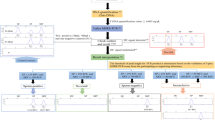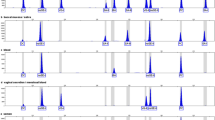Abstract
Identification of semen and then spermatozoa is essential to verify that sexual activity has occurred in alleged cases of sexual assault. Microscopic examination commonly used for spermatozoa identification is however time-consuming and can often lead to false-negative results for samples with deformed and, or, limited number of spermatozoa. To address this limitation, we report on a novel 3-plex MSRE-PCR (methylation-sensitive restriction enzyme-PCR) assay to specifically identify spermatozoa. This assay is comprised of 3 markers: a digestive control marker (DC), sperm-specific marker (SP), and Y chromosome marker (SRY). A total of 214 samples from 10 body fluids or tissues were analyzed. Specificity testing showed that all the normal semen samples were unambiguously identified as being sperm-positive, and no other body fluid (or tissues) showed a sperm-specific signal in the electropherogram. Testing for sensitivity showed that 0.1 ng of DNA from a semen extract was sufficient to identify the presence of spermatozoa by this assay. Mixture analyses illustrated the sensitivity of the assay when the vaginal/semen DNA ratio (80/0.1) was under 800 or the menstrual blood/semen DNA ratio (5/0.1) was under 50, the trace amounts (approximately 0.1 ng) of DNA from semen can still be identified by this 3-plex MSRE-PCR assay. This assay was also applied to the identification of 31 non-probative forensic samples from 18 sexual assault cases. The case studies showed that the 3-plex MSRE-PCR assay was an improvement in the sensitivity of spermatozoa detection.




Similar content being viewed by others
References
Malsom S, Flanagan N, McAlister C, Dixon L (2009) The prevalence of mixed DNA profiles in fingernail samples taken from couples who co-habit using autosomal and Y-STRs. Forensic Sci Int Genet 3(2):57–62
An JH, Shin KJ, Yang WI, Lee HY (2012) Body fluid identification in forensics. BMB Rep 45(10):545–553
Old J, Schweers BA, Boonlayangoor PW, Fischer B, Miller KW, Reich K (2012) Developmental validation of RSID™-semen: a lateral flow immunochromatographic strip test for the forensic detection of human semen. J Forensic Sci 57(2):489–499
Allery JP, Telmon N, Mieusset R, Blanc A, Rougé D (2001) Cytological detection of spermatozoa: comparison of three staining methods. J Forensic Sci 46(2):349–351
Henky H, Budiningsih Y, Widiatmaka W (2011) The validity of rapid test to detect prostate-specific antigen (PSA) in seminal fluid. Med J Indonesia 20(4):278–282
Sato I, Sagi M, Ishiwari A, Nishijima H, Ito E, Mukai T (2002) Use of the “SMITEST” PSA card to identify the presence of prostate-specific antigen in semen and male urine. Forensic Sci Int 127(1–2):71–74
Graves HC, Sensabaugh GF, Blake ET (1985) Postcoital detection of a male-specific semen protein: application to the investigation of rape. N Engl J Med 312(6):338–343
Suttipasit P, Wongwittayapanich S (2018) Detection of prostate specific antigen and semenogelin in specimens from female rape victims. J Forensic Legal Med 54:102–108
Casey DG, Domijan K, MacNeill S, Rizet D, O'connell D, Ryan J (2017) The persistence of sperm and the development of time since intercourse (TSI) guidelines in sexual assault cases at forensic science Ireland, Dublin, Ireland. J Forensic Sci 62(3):585–592
Hanson EK, Ballantyne J (2016) Enhanced DNA profiling of the semen donor in late reported sexual assaults: use of Y-chromosome-targeted pre-amplification and next generation Y-STR amplification systems. In: Forensic DNA Typing Protocols. Springer, pp 185–200
Katilius E, Carmel AB, Koss H, O’Connell D, Smith BC, Sanders GM, LaBerge GS (2018) Sperm cell purification from mock forensic swabs using SOMAmer™ affinity reagents. Forensic Sci Int Genet 35:9–13
Costa S, Correia-de-Sá P, Porto MJ, Cainé L (2017) The use of laser microdissection in forensic sexual assault casework: pros and cons compared to standard methods. J Forensic Sci 62(4):998–1006
Muro CK, Doty KC, de Souza Fernandes L, Lednev IK (2016) Forensic body fluid identification and differentiation by Raman spectroscopy. Forensic Chem 1:31–38
Roeder AD, Haas C (2013) mRNA profiling using a minimum of five mRNA markers per body fluid and a novel scoring method for body fluid identification. Int J Legal Med 127(4):707–721
Ingold S, Dørum G, Hanson E, Berti A, Branicki W, Brito P, Elsmore P, Gettings K, Giangasparo F, Gross T (2018) Body fluid identification using a targeted mRNA massively parallel sequencing approach–results of a EUROFORGEN/EDNAP collaborative exercise. Forensic Sci Int Genet 34:105–115
Sirker M, Fimmers R, Schneider P, Gomes I (2017) Evaluating the forensic application of 19 target microRNAs as biomarkers in body fluid and tissue identification. Forensic Sci Int Genet 27:41–49
Frumkin D, Wasserstrom A, Budowle B, Davidson A (2011) DNA methylation-based forensic tissue identification. Forensic Sci Int Genet 5(5):517–524
Jung SE, Cho S, Antunes J, Gomes I, Uchimoto ML, Oh YN, Di Giacomo L, Schneider PM, Park MS, van der Meer D (2016) A collaborative exercise on DNA methylation based body fluid typing. Electrophoresis 37(21):2759–2766
Jones PA (2012) Functions of DNA methylation: islands, start sites, gene bodies and beyond. Nat Rev Genet 13(7):484–492
Hashimshony T, Zhang J, Keshet I, Bustin M, Cedar H (2003) The role of DNA methylation in setting up chromatin structure during development. Nat Genet 34(2):187–192
Miranda TB, Jones PA (2007) DNA methylation: the nuts and bolts of repression. J Cell Physiol 213(2):384–390
Song F, Smith JF, Kimura MT, Morrow AD, Matsuyama T, Nagase H, Held WA (2005) Association of tissue-specific differentially methylated regions (TDMs) with differential gene expression. Proc Natl Acad Sci U S A 102(9):3336–3341
Wasserstrom A, Frumkin D, Davidson A, Shpitzen M, Herman Y, Gafny R (2013) Demonstration of DSI-semen—a novel DNA methylation-based forensic semen identification assay. Forensic Sci Int Genet 7(1):136–142
Sambrook J, Fritsch E, Maniatis T (1989) Molecular cloning: a laboratory manual:9.14–19.19. Cold Spring Harbor Laboratory Press, New York
Yu-Chih L, Li-Chin T, James Chun-I L, Kuo-Lan L, Jason Tze-Cheng T, Adrian L, Hsing-Mei H (2016) Novel identification of biofluids using a multiplex methylation-specific PCR combined with single-base extension system. Forensic Sci Med Pathol 12(2):128–138
Balamurugan K, Bombardi R, Duncan G, McCord B (2014) Identification of spermatozoa by tissue-specific differential DNA methylation using bisulfite modification and pyrosequencing. Electrophoresis 35(21–22):3079–3086
Tanaka K, Okamoto A (2007) Degradation of DNA by bisulfite treatment. Bioorg Med Chem Lett 17(7):1912–1915
Yu-Chih L, Li-Chin T, James Chun-I L, Chih-Wen S, Jason Tze-Cheng T, Adrian L, Hsing-Mei H (2016) Novel identification of biofluids using a multiplex methylation sensitive restriction enzyme-PCR system. Forensic Sci Int Genet 25:157–165
Krausz C, Sandoval J, Sayols S, Chianese C, Giachini C, Heyn H, Esteller M (2012) Novel insights into DNA methylation features in spermatozoa: stability and peculiarities. PLoS One 7(10):e44479
Reinius LE, Acevedo N, Joerink M, Pershagen G, Dahlén SE, Greco D, Söderhäll C, Scheynius A, Kere J (2012) Differential DNA methylation in purified human blood cells: implications for cell lineage and studies on disease susceptibility. PLoS One 7(7):e41361
Farkas SA, Milutin-Gašperov N, Grce M, Nilsson TK (2013) Genome-wide DNA methylation assay reveals novel candidate biomarker genes in cervical cancer. Epigenetics 8(11):1213–1225
Souren NY, Lutsik P, Gasparoni G, Tierling S, Gries J, Riemenschneider M, Fryns J-P, Derom C, Zeegers MP, Walter J (2013) Adult monozygotic twins discordant for intra-uterine growth have indistinguishable genome-wide DNA methylation profiles. Genome Biol 14(5):R44
Slieker RC, Bos SD, Goeman JJ, Bovée JV, Talens RP, van der Breggen R, Suchiman HED, Lameijer E-W, Putter H, van den Akker EB (2013) Identification and systematic annotation of tissue-specific differentially methylated regions using the Illumina 450k array. Epigenetics Chromatin 6(1):26
Untergasser A, Cutcutache I, Koressaar T, Ye J, Faircloth BC, Remm M, Rozen SG (2012) Primer3--new capabilities and interfaces. Nucleic Acids Res 40(15):e115. https://doi.org/10.1093/nar/gks596
Koressaar T, Remm M (2007) Enhancements and modifications of primer design program Primer3. Bioinformatics 23(10):1289–1291
Yu H, Diamandis EP (1995) Prostate-specific antigen in milk of lactating women. Clin Chem 41(1):54–58
Lövgren J, Valtonen-André C, Marsal K, Liua H, Lundwall Å (1999) Measurement of prostate-specific antigen and human glandular kallikrein 2 in different body fluids. J Androl 20(3):348–355
Cox M (1991) A study of the sensitivity and specificity of four presumptive tests for blood. J Forensic Sci 36(5):1503–1511
Kaye S (1949) Acid phosphatase test for identification of seminal stains. J Lab Clin Med 34(5):728–732
Vernarecci S, Ottaviani E, Agostino A, Mei E, Calandro L, Montagna P (2015) Quantifiler® Trio Kit and forensic samples management: a matter of degradation. Forensic Sci Int Genet 16:77–85
Sidstedt M, Hedman J, Romsos EL, Waitara L, Wadsö L, Steffen CR, Vallone PM, Rådström P (2018) Inhibition mechanisms of hemoglobin, immunoglobulin G, and whole blood in digital and real-time PCR. Anal Bioanal Chem 410(10):2569–2583
Funding
This study was supported by the Ministry of Science and Technology (NSC 102–2628-B-015-001-MY2), and Ministry of the Interior (108–0805-05-17-01) in Taiwan.
Author information
Authors and Affiliations
Contributions
All the authors contributed to the study conception and design. Material preparation, data collection, and analysis were performed by Kuo-Lan Liu, Li-Chin Tsai, Yu-Chih Lin, Nu-En Huang, Lih-Jing Yang, and Chih-Wen Su. The first draft of the manuscript was written by James Chun-I Lee, Adrian Linacre, and Hsing-Mei Hsieh, and all the authors commented on previous versions of the manuscript. All the authors read and approved the final manuscript.
Corresponding author
Ethics declarations
Conflict of interest
The authors declare that they have no conflict of interest.
Ethical approval
In this study, samples were collected after informed consent and following the procedures approved by the Institutional Review Board (IRB) of Taoyuan General Hospitals (IRB No. TYGH102011) and Antai-Tian-Sheng Memorial Hospital (IRB No. 18–074-B) in Taiwan. Neither the authors are affiliated to these hospitals nor the study was carried out in these hospitals. And the studies have been performed in accordance with the ethical standards as laid down in the 1964 Declaration of Helsinki and its later amendments or comparable ethical standards.
Informed consent
Informed consent was obtained from all individual participants included in the study.
Additional information
Publisher’s note
Springer Nature remains neutral with regard to jurisdictional claims in published maps and institutional affiliations.
Electronic supplementary material
Online Resource 1
(DOCX 19 kb)
Online Resource 2
(DOCX 42 kb)
Online Resource 3
(DOCX 18 kb)
Online Resource 4
(DOCX 309 kb)
Online Resource 5
(DOCX 155 kb)
Online Resource 6
(DOCX 137 kb)
Online Resource 7
(DOC 52 kb)
Online Resource 8
(DOC 154 kb)
Rights and permissions
About this article
Cite this article
Liu, KL., Tsai, LC., Lin, YC. et al. Identification of spermatozoa using a novel 3-plex MSRE-PCR assay for forensic examination of sexual assaults. Int J Legal Med 134, 1991–2004 (2020). https://doi.org/10.1007/s00414-020-02285-1
Received:
Accepted:
Published:
Issue Date:
DOI: https://doi.org/10.1007/s00414-020-02285-1




